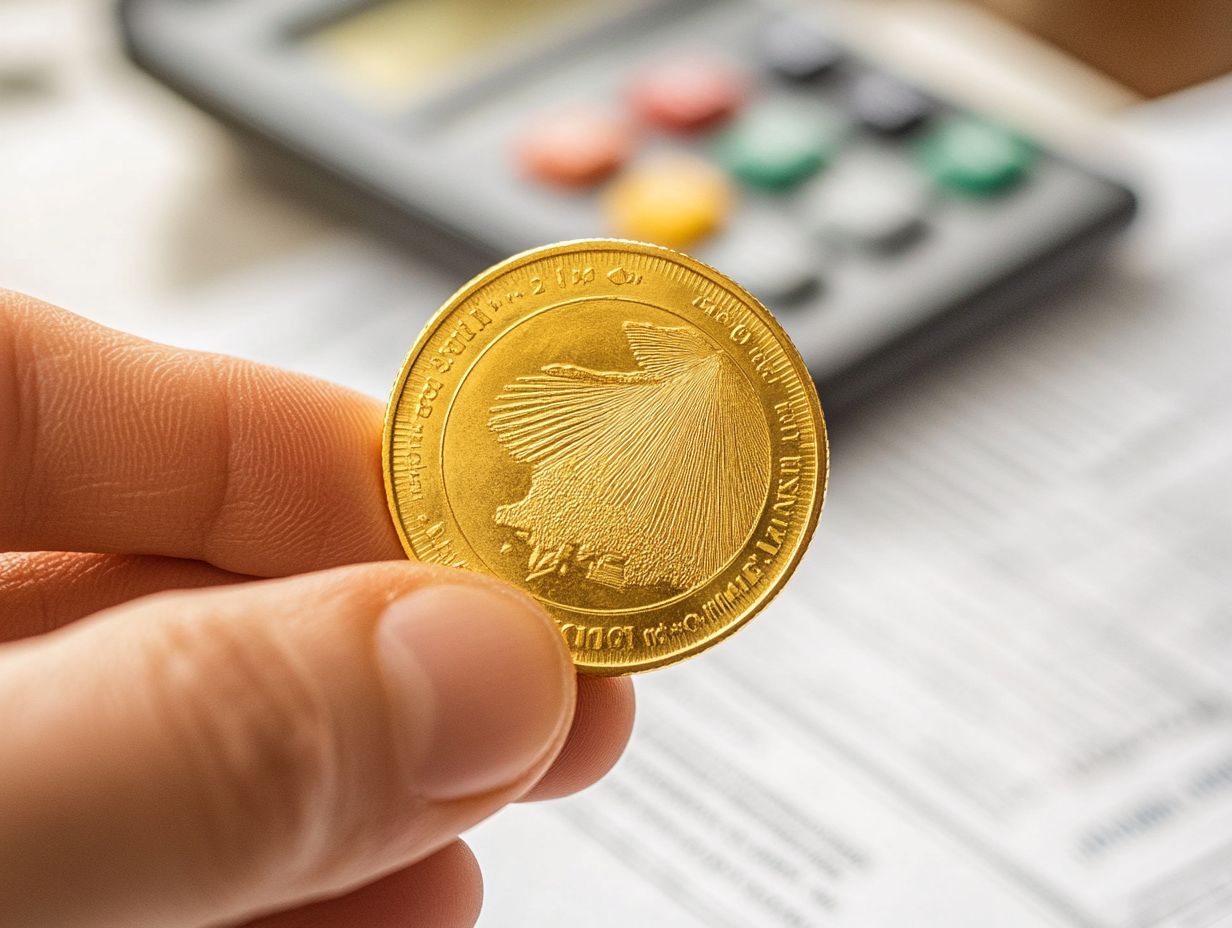Investing in a Gold IRA can be a strategic way to diversify your retirement portfolio, safeguard your wealth against market volatility, and benefit from potential tax advantages.
A Gold IRA is a type of individual retirement account that allows you to invest in physical gold and other precious metals, offering various investment choices to enhance your retirement savings.
This article explores the various types of Gold IRAs, the pros and cons of investing in precious metals, storage options, withdrawal rules, alternative investment options, and more.
By understanding these factors, you can determine if a Gold IRA is the right choice for your financial future and align it with your broader wealth management strategy.
Key Takeaways:
What is a Gold IRA?
A Gold IRA is a specialized retirement account that allows individuals to invest in physical gold, including gold coins and bullion, as part of their retirement savings strategy. This investment option offers the potential for tax-deferred growth in accordance with IRS regulations.
This type of account is designed to enable investors to diversify their portfolios while also providing a hedge against inflation and economic downturns. Additionally, it offers substantial tax benefits that can enhance your financial resources over time. Gold IRAs can encompass various precious metal assets, including gold, silver, platinum, and palladium, thereby offering a wide range of options for retirement planning.
In contrast to traditional IRAs and Roth IRAs, which typically emphasize stocks and bonds, a Gold IRA necessitates the involvement of a custodian responsible for the physical storage and security of the assets held in depository storage. Contributions to a Gold IRA can grow tax-deferred, meaning that individuals are not required to pay taxes on gains until withdrawals are made. This feature can lead to significant tax advantages over time, subject to the specific laws governing these investments.
Types of Gold IRAs

There are various types of Gold Individual Retirement Accounts (IRAs), including traditional IRAs, Roth IRAs, and SEP IRAs. Each of these accounts has distinct tax implications and regulations established by the Internal Revenue Service (IRS). Understanding these differences can help you make more informed investment decisions and leverage the appropriate tax benefits.
This diversity enables individuals to implement investment strategies that align with their specific financial objectives and asset allocation preferences.
How Does a Gold IRA Work?
A Gold IRA functions by permitting investors to fund their accounts through contributions or transfers from existing IRA accounts, subsequently enabling the purchase of approved precious metals. This process is facilitated by a custodian, who manages all transactions and ensures compliance with IRS regulations concerning contribution limits and required minimum distributions (RMDs).
This distinctive retirement vehicle typically necessitates an initial investment, which may originate from existing retirement accounts or direct contributions. Once the account is established, the custodian assumes a critical role by facilitating the acquisition of eligible gold products, ensuring compliance with IRS standards, and overseeing their storage in approved facilities.
Investors should also consider that, in addition to custodian fees for account maintenance, there may be storage fees that vary based on the security level and services provided by the storage facility. A comprehensive understanding of these operational elements enables investors to make informed decisions while optimizing their potential for financial growth.
What Types of Precious Metals Can Be Held in a Gold IRA?

In a Gold IRA, various types of precious metals may be held, including gold coins, gold bullion, and certain IRS-approved products made of silver, platinum, and palladium. These investments are governed by specific IRS regulations that dictate their eligibility, ensuring they meet standards for purity and authenticity to maintain their investment value.
These regulations ensure that the metals included meet certain standards of purity and authenticity, thereby fostering a secure investment environment. For instance, gold must generally be at least 99.5% pure, while silver is required to be 99.9% pure to qualify for inclusion.
Plus traditional gold coins, such as the American Gold Eagle, investors may also consider silver rounds or bars, as well as platinum bars that satisfy the purity criteria. Palladium is increasingly gaining popularity, with products like the Palladium Maple Leaf gaining traction in the market. Each of these options offers distinct advantages, enabling individuals to diversify their retirement portfolios while remaining compliant with IRS standards.
Where is the Gold Stored?
The gold held in a Gold IRA is typically stored in secure depository storage facilities that are approved by the IRS. These facilities ensure the safety and integrity of the physical gold while incurring applicable storage fees charged by the custodians.
These depositories provide various levels of protection, including surveillance, secure locks, and insurance coverage, to safeguard investors’ assets. When selecting a custodian, it is essential to understand the types of storage options available, such as segregated or commingled storage, as these can influence both security and costs.
Potential investors should be aware of any ongoing fees associated with their chosen facility, as these fees can vary significantly depending on the services provided. A thorough evaluation of these factors not only ensures peace of mind but also supports long-term investment strategies in precious metals.
When Can You Withdraw from a Gold IRA?

Withdrawals from a Gold IRA may generally commence upon reaching the age of 59½, permitting tax-free distributions. Additionally, required minimum distributions (RMDs) must be initiated starting at age 72, in accordance with IRS regulations pertaining to retirement accounts.
A comprehensive understanding of the withdrawal process is essential for effective financial planning and to avoid incurring unnecessary penalties or tax liabilities.
Upon turning 59½, individuals have the option to withdraw funds without incurring the typical early withdrawal penalties; however, any distributions taken prior to this age may result in substantial tax liabilities.
It is imperative to recognize that RMDs, which are mandated withdrawals from retirement accounts, are intended to ensure that individuals begin to utilize their retirement savings. Noncompliance with RMD requirements can lead to significant penalties. Therefore, being cognizant of the timing and amount mandated is crucial to avoid unnecessary tax burdens and to ensure adherence to IRS regulations governing Gold IRAs.
Pros and Cons of Investing in a Gold IRA
Investing in a Gold IRA presents numerous advantages, including the benefits of diversification, serving as a hedge against inflation, and providing protection against economic risks.
However, it also entails certain disadvantages, such as custodian fees, storage fees, and the necessity for meticulous investment strategies to navigate market turmoil and protect against economic risks.
How to Open a Gold IRA
Opening a Gold IRA requires selecting a reputable custodian, engaging in consultations with financial advisors to discuss investment strategies, and completing the necessary documentation for an IRA transfer or new contributions, all of which may involve custodian fees. Consulting with advisors from institutions like Green Bee Advisory LLC can provide tailored guidance to align your investments with your retirement plans.
The first step in this process is to conduct thorough research and compare various custodians who specialize in precious metals. It is essential to assess their fees, customer service, and overall credibility. Reputable sources like USA TODAY and Bankrate can be useful for this assessment.
Once a custodian has been identified, prospective investors should consult with financial advisors well-versed in the complexities of gold investments and retirement funds.
These advisors can provide tailored guidance that aligns with individual financial objectives and risk tolerance.
Following these consultations, the next phase involves preparing and submitting the required documentation, which typically includes account applications and transfer forms, ensuring that all necessary information is accurately conveyed to facilitate smooth transactions.
Alternatives to Investing in a Gold IRA
Individuals exploring alternatives to investing in a Gold IRA may consider options such as gold stocks, gold mutual funds, and gold exchange-traded funds (ETFs), each offering a different risk profile and potential for capital gain within the gold market.
Each of these alternatives presents distinct advantages as investment vehicles, while still offering exposure to the gold market.
Bottom Line: Should You Consider a Gold IRA?
The decision to consider a Gold IRA ultimately rests on individual investment preferences, as it can provide a hedge against inflation risks and serve as a valuable component of a comprehensive wealth management and retirement strategy. Consulting with experts such as Maryalene LaPonsie or Catherine Valega from reputable advisory firms can provide further retirement advice tailored to your specific needs.
Investors often find themselves assessing the benefits of stability and diversification offered by a Gold IRA against the potential challenges related to costs and the complexities of managing such an investment, especially in a self-directed IRA. While physical gold has historically preserved its value over the long term, it is important to take into account market fluctuations, depository storage fees, and custodian fees that may affect overall returns.
As individuals contemplate their retirement plans, it is crucial to evaluate how gold integrates into their broader asset allocation strategy and overall investment portfolio, ensuring alignment with personal financial objectives, including retirement savings. A well-considered approach can contribute to a more resilient retirement portfolio and provide diversification benefits. Additionally, considering investment choices like gold stocks, gold mutual funds, and gold ETFs, alongside traditional options, is essential for effective financial planning.
Gold IRAs offer tax benefits, such as tax-deferred growth and, in some cases, tax-free distributions. This can be particularly advantageous for those looking to hedge against inflation risks and market turmoil. In addition, consulting financial advisors who specialize in gold investments can further optimize your investment strategies. Entities like Noble Gold Investments and Green Bee Advisory LLC offer valuable retirement advice and wealth management services to ensure your gold holdings are in compliance with IRS rules and contribution limits.
Moreover, understanding IRS regulations regarding RMDs (required minimum distributions) and capital gains associated with gold purchases, including American Eagle coins, is crucial for informed investment decisions. Entities like the SEC and financial publications like USA TODAY and Bankrate offer resources to enhance your knowledge on economic risks and the gold market. Educational institutions such as Western Michigan University also provide insights into the complexities of managing alternative investments within retirement accounts, including traditional IRA, Roth IRA, and SEP IRA plans.
